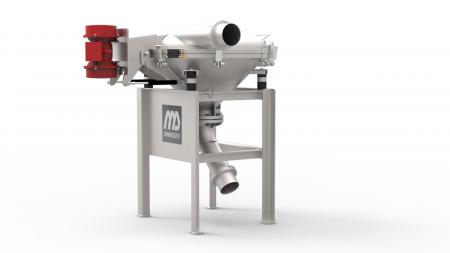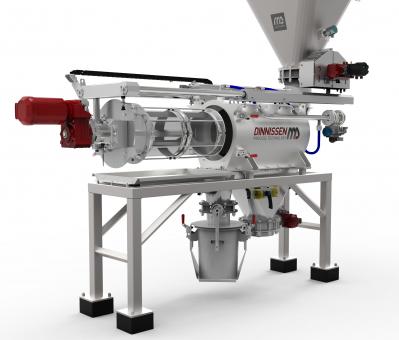Sieving powders, particles, and granules.
With a sieve it is possible to separate large and small particles. This article will discuss:
- Separating mixtures by means of a sieve
- Different types of screening machines
The experts at Dinnissen Process Technology are available to answer all your questions:
Get in touch with Juul Jenneskens 077 467 3555
Principle sieve
A sieve is a tool used to separate mixtures of powders, particles or granules based on grain size. Screens can also be used to separate solid particles from liquids. The separating effect of a sieve is based on a plate provided with holes of one diameter. From a mixture of large and small particles deposited on the sieve plate, the small particles will pass through the holes in the sieve plate and the large particles will be retained by the sieve plate. What does or does not pass through the sieve plate is thus sorted by size of particles that are either larger or smaller than the openings in the sieve plate.
In daily life, sieves are used regularly and applied in different ways. In the kitchen, sieves are used, for example, to sieve flour or flour, or to rub jelly-like substances through them to prevent lumps. Here the sieve not only has a separating effect, but the sieve also ensures that parts of the mixture get a smaller size.
Various types of screening machines are used in industry to separate mixtures of particles. Consider, for example, machines used to sort agricultural products by size, to sort waste and to remove stones from sand.
Using the principle of sieving described above, a number of operations are possible in various types of screening machines:
- Scalping: this is the capping of a small proportion of coarse particles from a product stream.
- Control: intended for safety screening of contaminants.
- Fractionation: this refers to dividing a product stream into various product fractions based on grain size.
- Dedusting: this is the removal of the dust content in the product flow.

Vibrating sifter
Types of screening machines
Various types of screening machines are used in the industry for numerous applications. The following screening principles are most common in the screening machines used:
- Drum sieve
- Tumble sieve
- Centrifugal sieve
- Vibrating sieve - Flat sieve - Shaking sieve
- Plan closer - multi-deck sieving machine
Drum sieve
The operation of a drum sieve is based on the separation of particles of different sizes by means of a revolving drum. The drum is tilted so that the particles move downwards by gravity. A screen perforation has been made in the drum, so that the smaller particles can escape and a separation between the larger and smaller particles takes place.
The separation is non-destructive, which means that both the fine and the coarse product can be reused.
The capacity depends on a number of things. Machine-dependent matters are of course important, such as the dimensions of the drum, the sieve perforation and the rotational speed of the drum. Finally, the properties of the mixture are also important, for example it concerns a mixture of which the dimensions of the particles are very different or a mixture that is moist and sticky.
Tumble sieve
A tumble sieve is a machine that can move material mixtures to be sieved over a sieve deck by means of horizontal and vertical movements. Depending on the material to be sieved, the amplitudes of the movements can often be set independently of each other. It is also often possible to place several screen decks one above the other in the machine. The position of the screen deck determines the size of the perforations in the deck. The higher the position of the screen deck, the larger the perforation openings in it. This division ensures that the largest particles remain on the top deck and the smaller particles fall through the perforations to a lower positioned screen deck.
A sieve is a tool used to separate mixtures of powders, particles or granules based on grain size. sieves can also be used to separate solid particles from liquids
Centrifugal sieve
A centrifugal sieve works on the principle of centrifugal force. A centrifugal force is created by a rotating movement. This principle is applied, for example, in a washing machine, where the water contained in laundry is thrown out and leaves the washing drum via perforations.
Via the same principle, in a centrifugal sieve, particles of a mixture of different sizes are pressed against a basket-shaped sieve plate by means of centrifugal force. The smaller particles that pass through the perforations pass through the sieve basket and the coarser particles remain in the sieve basket. These larger particles can be discharged through a special outlet.
The particle mixtures are often supplied by gravity or pneumatic transport. The capacity of the centrifugal sieve depends on the size of the drum, but also on the spin speed and the composition of the mixture.

Centrifugal sieve
Vibrating sieve - Flat sieve - Shaking sieve
As the name “vibrating sieve” implies, vibrations are used in a vibrating sieve machine to separate a mixture of granular materials. The name flat screen is also used more often for this type of screening machine. If the horizontal displacement of the mixture has also been added as a function, the machine is often referred to as a “vibrating screen”. Making the vibrating deck vibrate causes the grains to move. As soon as smaller particles arrive on the screen deck, they will fall through the screen deck via the screen perforations. The coarser grains remain on the screen deck. The mixtures to be screened are often supplied by dosed pouring.
This type of screeners is available in various versions, both round and rectangular versions are possible. Sometimes these types of screening machines are equipped with a vibrating screen deck. In cases where this type of machine is equipped with a tumbling mechanism, this sieve could also be called a tumbling sieve machine.
Plan closer - multi-deck sieving machine
As early as the 19th century, the plan builder was used in mills to sieve ground grain. It is originally a reciprocating screen consisting of 8 to 15 screen decks stacked one above the other. Small moving brushes above each sieve layer ensure that the sieve decks do not clog. The meshes of the sieves vary from 100 to 1000 μm. The heaviest parts of the grain, the bran, are left on the upper sieve decks. The coarse, medium and coarse groats are conveyed to the underlying sieve decks and the flour finally remains on the lower decks.
Nowadays, planning makers are still used in the industry for the separation of powder mixtures, application examples are rice, corn, animal feed, wood, cellulose and herbs. Depending on the application, more or less screen decks can be used. In order to increase the capacity, several sieve stacks are often connected in parallel. The plan maker's commitment to sieving offers a number of benefits:
- Separation into a large number of components is possible,
- Sieving process well controllable, also for large to large capacities,
- Easy operation,
- Low cost price due to the simple construction,
- The machine is maintenance-friendly and easy to clean.
Derived from the plan founder, the multi-deck screening machine was also developed. In terms of construction, both machines are the same. In the multi-deck screening machine there are also several screening decks one above the other. The multi-deck screening machine is also available for large screening surfaces (up to 100 m2).
